Sam's Media Blog...
- Sam
- United Kingdom
- A/S Level Media Studies Blog
Friday, 12 December 2008
Thursday, 4 December 2008
Monday, 1 December 2008
Thriller Target Audiences.
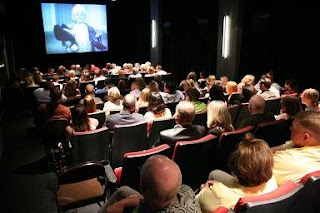
Like with all genres of film, there are sub-genres, so the a target audience simply for 'thrillers' cannot be identified. However, more action based thrillers, such as Speed, are likely to have a younger age target audience than a psychological thriller, such as The Machinist. Also, it is likely that thrillers appeal more to men than women, unless of course the film in question is I-Robot, which many teenage girls watch, simply to see Will Smith semi-naked in a shower. They appeal more to men, probably because of the mystery involved. However, thrillers in general would appeal to anyone who likes to work things out for themselves, to follow a mystery and solve it, and who enjoy the element of surprise.
Opening Comparison - Duel & Speed
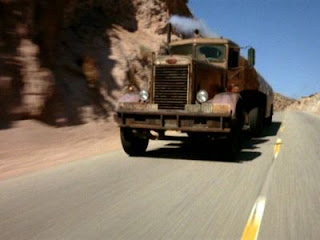
Duel, 1972, Steven Spielberg
Camera - The camera is positioned on the front of a car, at around bumper level. Someone gets into the car, and reverses out of their driveway. The sequence is sped up heavily, but it is still clear to see that the car heads on a normal journey, through a busy city, before heading into a very remote area of countryside, or possible desert, where there is no other traffic on the road. This opening shot actually appears to last for a couple of minutes, but where it is sped up, there are probably edits concealed to move the journey on faster. Eventually, when the car is deep in the desert, the shot changes to high angle panning shot of the car, moving along the road from left to right, with a mountainous backdrop. This shot, combined with only the noise of the car, emphasise how remote the area is, and it's important the audience perceive this sense of solitude, as it adds to the confusion that surrounds the opening, creating questions in the audience's mind. There is then a shot of the car's rear view mirror, allowing the audience to see the driver for the first time, who looks dressed for business, and very 70's. There is then a close up of his face, with little expression, as he drives on.
Editing - There are not many edits at all in the opening minutes, simply because the first shot appears to be so long. The edits are used and slow fade in/fade outs and dissolves, which gives the impression of time passing, making his journey seem all the more tedious. Also, there may be concealed edits in the first shot, to move the journey on quicker.
Sound - Diegetic sound of the man entering his car, shutting the door, starting the engine and driving away. However, the car radio is on throughout the opeing, but it is none-diegetic, as it runs at a normal pace and is continous, despite the first shot being sped up and there being edits after this. On the radio itself is a dreary presenter, talking in a continuous monotone. This again gives the impression that the journey is long, boring, and tedious. At one point, the driver changes the station to some Jazz, but soon changes back again, also showing he is becoming tired and bored of the journey, trying to pass time.
Mise-en-Scene - The busy city and desert contrast is important in emphasising length of the journey, remoteness. Other than this, there is little features of importance. Perhaps the man's smartish clothing and glasses, and the shot in the rear view mirror could be argued to be important. Also the use of the car - the whole opening sequence is based around the car and the journey. When we see the truck for the first time, later on in the opening, it is really loud, dirty, old and smokey, making it look suspicious to the audience, and have a sort of 'scary' image. The audience don't see the driver of the truvk either, which raises the question of 'who is he?' in the audience's mind, and adds to the mystery and suspense.
Titles - Appear only when the car is entering tunnels, of which there is a string of. The text is a yellow, 'Flintstone' style font, which is a strange choice for a thriller.
Speed, 1994, Jan De Bout
Camera - Moves down a lift shaft, with very dark lighting, the audience see lots of floors 'going by' suggesting the building is very tall. The camera is from the point of view of the lift, as if it were attached to it travelling down the building. As the lift raches the bottom, the camera appears to continue in the same shot, moving and panning to the left, where it focuses on a 'caution' sign above a dorrway, then pans down to a bloke opening the door. This looks like one continous shift, however, the camera moves past a gurder as it veers to left, where a sneaky edit is most likely concealed.
Editing - Appears the be one continuous shot throughout the opeing, but one sneaky edit is hidden by the gurder at the bottom of the shaft. This is a really fast edit, and the second shot starts in the finishing place of the first, making the edit seamless.
Sound - Violins, music is rather fast, upbeat, but still creates tension, with the feeling it's building up to something. The opening would be really inneffective and tedious if the music wasn't present, or if it was slowed down. The music makes the opening. Also, there is a 'wooshing' sound effect as the titles rush off-screen.
Mises-en-Scene - Lift shaft, dark lighting, and a knife used in the stabbing involving the man who comes through the 'caution' door. The 'caution' sign, followed immediately by a stabbing is rather ironic, as that's probably not the sort of thing he was being cautious of.
Titles - Blue 'neon' style block font, to the right hand side of the screen, and they appear as the lift goes past each floor, then quickly dissappear. The film title 'Speed' appears in much bigger letters than the actors names.
Comparison
I personnally think that the opening of Duel is much more effective, in that it ticks more boxes of the traits to which thrillers should conform. Although the opening is quite tedious, it suggests the film could be quite a psychological thriller, or at least a slower paced path of confusion, where the audience can think about what twists may be occurring. Also, unlike in Speed, there is a clear indication as to where the film is heading. The title 'Duel' combined with the emphasis on the truck allows anyone with a duty-free brain cell to see that there is going to be some form of conflict between the truck and car driver. It is not clear where speed is heading. Also, despite the clarity of the opening of Duel, it still raises more questions in the audience's mind, and there is more suspense in the opening, as no action really happens, whereas in Speed, someone is killed with very little warning - rather unusual for a thriller - there is normally some form of build up, and the audience generally know when some thing like a murder is likely to happen.
Film Noir - A Brief Definition
Literally, “dark film,” a term applied by French critics to a type of American film, usually in the detective or thriller genres, with low-key lighting and a somber mood. Especially popular in the 1940s-50s, these films are characterized by use of deep shadows, a detective plot, hidden motives, characters motivated by selfishness, greed, cruelty, etc.
Psycho - Dinner in the Parlour Scene
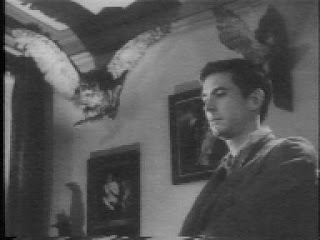
Camera cuts to stuffed birds on the wall, they are predators - Raven, owl, strong use of shadow to impose their image and power - low angle shot makes the audience feel vulnerable, perhaps a sign that something bad is about to happen. Lots of use of shot/reverse shot, used in conversation between Norman and Marion. Throughout the conversation, Marion is in quite a dark corner, but with harsh light on her face, with the shots of her being either close ups or over the shoulder shots. When Norman is talking, a low angle mid shot is used so the audience can see the stuffed birds, we begin to associate their and his image with being rather dark and shifty, we know something sinister is in the pipeline. There is also a striking use of lighting, illuminating one side of Norman's face, shadowing the other - again adds to the dark nature of the sequence. When Marion suggests Norman should put his mother "some place", he leans forward, and the tension creating violins kick in again, suggesting he's none too chuffed with Marion. The close up shot of the birds on the wall following reinforces this. By leaning forward and creating a close up, Norman emphasises his power over Marion to the audience. There is an edit, and the music starting also adds to the feeling of his power. He is visibly angered, and has an aggressive tone to his voice for the first time in the sequence. He then grins, and this signifies the change in mood - "we all go a little mad sometimes." It is unclear to the audience whether this is a sign that he is forgiving Marion for what she said, or whether Norman is close to going 'over the edge.' When Marion stands up, she is filmed in a low angle shot, and Norman in a high angle, perhaps signifying a change in power (makes Marion look in control of the situation). When she leaves, the violins start again, signifying Norman is up to something shifty, and he watches Marion leave in a very voyeuristic manor.
The Machinist - Film Analysis
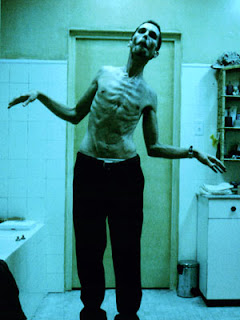
In the opening minutes of The Machinist, the main character, Trevor Reznik, is shown disposing of a body rolled up in a carpet with his face smeared in blood. He looks a bit mad, and is scarily thin. He’s presented as a bit of a loner; who’s stuck in a routine. He’s an insomniac who hasn’t slept in over a year, working with heavy machinery in a factory and sleeping with a prostitute, his life seems to play in a loop. Because of is we sympathise with him as an audience, despite the fact that he may well be a killer. We see a side in him, portrayed in his dead end job and poor quality of life that we can relate to. This wins us over to ‘his side.’ The lighting and mise en scene used in the opening of the film complements Trev’s dark and dingy life. Very little light is used, and we first meet Trev in a storm in the dead of night, and even indoor scenes are filmed with very little use of light. The only light we see is the harsh bright lights of the Airport Café, where Trev is indulging in Coffee and a Muffin, whilst trying to chat up the waitress. The camera cuts to the clock, which reads 1:30am. This complements nicely with the harsh lighting, giving us an insight into his life and inability to sleep. We always see Trev in dark clothing, and when we see him in his bathroom mirror is used to portray just how thin he his. He is also rubbing his hands with bleach, perhaps suggesting he is trying hard to clear himself and erase memories of the body he has just disposed of. Close ups with a strong use of shadow are used frequently to portray Trev as a dark character. There is also a lot of use of over-the-shoulder shots and low angle shots, which makes the character seem more powerful. Each shot is quite long – there are no fast edits, which slowly builds suspense. As the film begins, we hear a distant siren, which is twinned with slow, eerie music. There is also repetition in dialogue – “If you were any thinner you wouldn’t exist.”
The opening of The Machinist establishes the film as a thriller by meeting all the criteria that thrillers normally follow. Firstly, it is rather thrilling. We see Trev disposing of a body rolled up in a carpet, which immediately prompts questions in the viewer’s mind: Who is it? Has Trev killed him? Why has he been killed? Also, when a voice asks “who are you?” the audience want to find out who is asking. Another key to a thriller is the build up of suspense, which is apparent in the opening minutes of the film. We can see that with Trev working with machinery and being unable to sleep, some form of accident is inevitable. Also, the questions that are raised in the viewer’s mind help establish suspense. There are other common thriller traits too, such as low-key lighting, which is used throughout the opening, tense music and the use of dialogue. Trevor is also quite a complex character: On the one hand he could be a murderer, and on the other he is in a dead end job and as an audience we begin to sympathise with him, and crave to know more about him.
The opening of The Machinist establishes the film as a thriller by meeting all the criteria that thrillers normally follow. Firstly, it is rather thrilling. We see Trev disposing of a body rolled up in a carpet, which immediately prompts questions in the viewer’s mind: Who is it? Has Trev killed him? Why has he been killed? Also, when a voice asks “who are you?” the audience want to find out who is asking. Another key to a thriller is the build up of suspense, which is apparent in the opening minutes of the film. We can see that with Trev working with machinery and being unable to sleep, some form of accident is inevitable. Also, the questions that are raised in the viewer’s mind help establish suspense. There are other common thriller traits too, such as low-key lighting, which is used throughout the opening, tense music and the use of dialogue. Trevor is also quite a complex character: On the one hand he could be a murderer, and on the other he is in a dead end job and as an audience we begin to sympathise with him, and crave to know more about him.
The Machinist - Film Overview
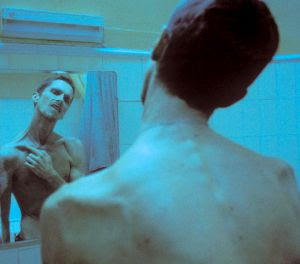
The Machinist is a psychological thriller, released in 2004, starring Christian Bale as sleep deprived Industrial Machinist Trevor Reznik. The film basically follows Trev on a long and confusing journey through his own mind, where his paranoia creates the mythical character Ivan (who is in fact Trevor), whom he blames for the crimes and mistakes he commits.
Throughout the film there are recurring themes, which seem irrelevant at the time, but as the film climaxes we realise their importance, and the questions that are formed in the viewers mind are answered. Examples of this the Hangman on the fridge door, the use of the question “who are you?” and, most subtly, but arguably most importantly, Trev’s reluctance to use the cigarette lighter in his pick up. We later discover that a year previously, Trev was involved in a hit and run, where he motored a boy identical to Nicholas whilst lighting a cigarette, before reporting his car totalled.
Trevor’s strange behaviour at work means his colleagues stay clear of him, and his reputation is hardly helped when he inadvertently switches on a machine Miller is working on, resulting in his left arm parting company with his torso. After another near accident, Trev’s paranoia reaches a new level, and he lashes out at his co workers, resulting in him being fired. He thinks that the occurrences in his life are an effort to drive him insane. The only comfort he finds is in prostitute Stevie, who develops genuine affection for him, and in Maria, the waitress in the Airport café, and mother to Nicholas, who we find out Trevor hits. From thereon in, the film basically focuses the viewers mind on trying to find out who Ivan is, and, to some extent, who Trev is. Of course, everything becomes alarmingly clear as mud at the end when we discover Ivan is actually Trevor, all be it his bad half.
The film was well received by reviewers, with website Rotten Tomatoes (clearly a serious and trustworthy sounding organisation) claiming that 73% of critics’ reviews were deemed positive.
Some reviews claim that the film “grips you like a vice”, others saying "Anderson's gloomy aesthetic may exert a sour but lingering pull", which I’m sure probably means something, and one even reads that the climax is “predictable to anyone who’s read Miss Marple.”
The opening of the film establishes it as a thriller by meeting the common criteria by which most thrillers comply. The character complexity is clear for all to see; we feel sorry for Trev, despite that fact we later find him to be a hit and run driver. The repetition of the phrase “who are you?” also raises questions in the viewers mind, and builds the suspense and uncertainty in what will happen next that is apparent throughout the film. We also see that Trev is a chronic insomniac, who by day works with heavy and potentially deadly machinery – we can see something will go wrong, which inevitably it does. Other common thriller traits that feature in the film are low key lighting, slow, suspense building music, and the use of dialogue.
Throughout the film there are recurring themes, which seem irrelevant at the time, but as the film climaxes we realise their importance, and the questions that are formed in the viewers mind are answered. Examples of this the Hangman on the fridge door, the use of the question “who are you?” and, most subtly, but arguably most importantly, Trev’s reluctance to use the cigarette lighter in his pick up. We later discover that a year previously, Trev was involved in a hit and run, where he motored a boy identical to Nicholas whilst lighting a cigarette, before reporting his car totalled.
Trevor’s strange behaviour at work means his colleagues stay clear of him, and his reputation is hardly helped when he inadvertently switches on a machine Miller is working on, resulting in his left arm parting company with his torso. After another near accident, Trev’s paranoia reaches a new level, and he lashes out at his co workers, resulting in him being fired. He thinks that the occurrences in his life are an effort to drive him insane. The only comfort he finds is in prostitute Stevie, who develops genuine affection for him, and in Maria, the waitress in the Airport café, and mother to Nicholas, who we find out Trevor hits. From thereon in, the film basically focuses the viewers mind on trying to find out who Ivan is, and, to some extent, who Trev is. Of course, everything becomes alarmingly clear as mud at the end when we discover Ivan is actually Trevor, all be it his bad half.
The film was well received by reviewers, with website Rotten Tomatoes (clearly a serious and trustworthy sounding organisation) claiming that 73% of critics’ reviews were deemed positive.
Some reviews claim that the film “grips you like a vice”, others saying "Anderson's gloomy aesthetic may exert a sour but lingering pull", which I’m sure probably means something, and one even reads that the climax is “predictable to anyone who’s read Miss Marple.”
The opening of the film establishes it as a thriller by meeting the common criteria by which most thrillers comply. The character complexity is clear for all to see; we feel sorry for Trev, despite that fact we later find him to be a hit and run driver. The repetition of the phrase “who are you?” also raises questions in the viewers mind, and builds the suspense and uncertainty in what will happen next that is apparent throughout the film. We also see that Trev is a chronic insomniac, who by day works with heavy and potentially deadly machinery – we can see something will go wrong, which inevitably it does. Other common thriller traits that feature in the film are low key lighting, slow, suspense building music, and the use of dialogue.
Other Points of Relative Interest:
- The film is set in a West Coast American city, despite being shot entirely in Barcelona, Spain.
- Also, Brad Anderson hurt his back during filming, and directed much of the film while lying on a medical trolley. If that’s not dedication, then I don’t know what is. Congratulations to the man.
Alfred Hitchcock's Psycho - Opening Sequence

In the opening scene, the mise-en-scene establishes the hotel room as the camera pans straight to the bed, with a medium shot of Marion lying down, with Sam's torso and legs to the side. Also, the fact that see Marion in her underwear is quite extreme, and almost unheard of in 1960. This technique would have shocked the audience, and grabbed their attention for the rest of the film. In terms of costume, Marion is wearing a white bra and underskirt, suggesting the pair have just had sex, but the wearing of white also suggests that in terms of representation, Marion is innocent and pure - or at least far too innocent to steal $40,000, surely? A cut-away shot is used to show the uneaten lunch - this again reinforces the view that she has just had sex, and that she is in her lunch hour away from work. As for the Texan (who Marion steals the money from) he is represented as being big-headed, over confident, and not at all nice. He tries to be funny, and fails miserably, and is very boastful about his cash. He says he "never carries more than I can afford to lose", which is as good as asking to be robbed. He tries to flirt with Marion, and the audience can tell from her body language that she probably wouldn't have made away with the cash had he not been so patronising, and besides, he didn't seem to care about losing his cash anyway.
The Interpreter - Analysis of Opening
Camera - High angle long shot of car on the road, followed by a mid shot through the windscreen. Paused Point of View shots signinfy photographs taken through a camera. Focus-pull shot, where the children are shown walking out of shot with guns after a murder in the background, then pulled into foreground showing a football. Signifies how the children should be innocent in their youth, but they clearly aren't. There are lots of slow, panning shots throughout the opening.
Editing - Cuts into the notebook, in which the man is writing. Dark lighting in the building, quite lengthy shots throughout, straightforward edits - little use of fades, just simple cuts.
Sound - Wind howling as they drive down the dust track, supposed to be diegetic, t is rather loud, so is probably dubbed over the top, therefore non-diegetic. Noise of car driving by stationary camera, backing music to create tension in opening sequence.
Mise-en-Scene - Camera used to show they are sightseers, or perhaps journalists or investigators. Lots of guns used, carried by the children, part of the murder sequence. Use of the football, which is emphasised by the focus pull shot, signifying the children should be innocent. The tourists, or journalists (the audience is unnaware of who they are during the opening sequence) are wearing simple, casual clothing, t-shirt and shorts. We then see a United Nations meeting taking place - UN uniform, smart clothing, office setting. There is also heavy dust in the opening shot, where the car is driving down the track.
Titles - The titles appear in different, random places on the screen,they fade in and fade out, with long gaps in between. Each actor's name stays on screen for quite a long time.
Editing - Cuts into the notebook, in which the man is writing. Dark lighting in the building, quite lengthy shots throughout, straightforward edits - little use of fades, just simple cuts.
Sound - Wind howling as they drive down the dust track, supposed to be diegetic, t is rather loud, so is probably dubbed over the top, therefore non-diegetic. Noise of car driving by stationary camera, backing music to create tension in opening sequence.
Mise-en-Scene - Camera used to show they are sightseers, or perhaps journalists or investigators. Lots of guns used, carried by the children, part of the murder sequence. Use of the football, which is emphasised by the focus pull shot, signifying the children should be innocent. The tourists, or journalists (the audience is unnaware of who they are during the opening sequence) are wearing simple, casual clothing, t-shirt and shorts. We then see a United Nations meeting taking place - UN uniform, smart clothing, office setting. There is also heavy dust in the opening shot, where the car is driving down the track.
Titles - The titles appear in different, random places on the screen,they fade in and fade out, with long gaps in between. Each actor's name stays on screen for quite a long time.
Sunday, 30 November 2008
Silence of the Lambs - Analysis of Opening
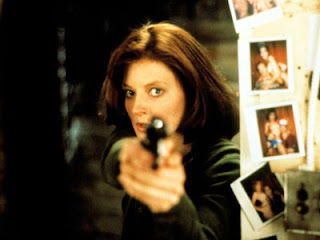
The opening shot of the scene is a silhouette of tree. There is no camera movement, and there is heavy mist in the background, limiting the audiences view of what is lurking beyond the tree; already creating a feeling of suspense and mystery. It is a low angle shot, making the audience feel weak and vulnerable. The sound consists of bird noises, and a non-diegetic soundtrack with a violin, and a chello creating lower, suspense building notes. The titles appear in the middle of the screen dubbed over the opening shot. The lettering is a black 'block' style with a white outline, in-keeping with the FBI theme that runs through the opening sequence. 'Jodie Foster' is the first name that appears, as she is the main star of the film. The camera then, still in one continuous shot, pans down and to the left deeper into the forest from the tree, creating a high angle establishing shot. A few other names of the main stars appear on screen before the film name appears. The camera then settles on Clarice (Jodie) in the distance, working her way up through the forest towards the camera. As she reaches the top, we can hear that she is out of breath, the camera retracts slightly as she pauses and looks around, before running out of shot to the right. Actors names then appear on the screen three at a time, signify that they are lower in the 'pecking order' of stars. As this happens, the camera follows Clarice from a distance, creating a long tracking shot and giving the impression she is running away, although at this point it's quite clear she's doing an assault course. The shot then cuts to close up of her face as she runs, then zooms out slightly into a mid shot of her head and shoulders as she runs, still with the opening music dubbed over. The shot then again cuts, this time to a side angle mid shot from her rights hand side, the camera still moving with her, as she runs through the trees. This way this is shot from behind the trees makes it look quite voyeuristic. The shot then cuts to a close up of her feet as she's running, with the crunching of the leaves underfoot apparent in the sound. As with all the edits in this sequence, the shot is formed from a simple cut, rather than using fades or other effects. More actors names appear on the screen again - but the fact that no actors names appeared during the side angle shot may suggest that this was of greater importance than other shots. The camera then cuts again to a side shot of her face (close up), and again then a tracking shot behind her. She then climbs over a scramble net, and the camera moves around the side of the obstacle, and picks Clarice up from the front angle. All of this sequence is in accordance with the 180 degree rule, meaning it is only shot from the front, the back, and one side, so the camera never goes beyond 180 degrees. This makes it easier for the audience to follow, and also shows continuity in the sequence. The camera then stays still allowing Clarice to run off into the distance. Someone off-screen shouts her, and then runs into shot towards her, and she turns around. The camera then moves towards, with Jodie bending over, exhausted, making the man she is talking to look powerful. She runs again out of shot, and the man turns around, watching her. This creates a close up of his face, and the audience can see he has an FBI cap on - this suggests for the first time in the film that Clarice has some connection with the FBI, and is training with them. There is another edit, and the camera pans down a tree, with signs on it reading from the top “hurt” “agony” “pain” “love it.” The camera then pans to the left, picking up Clarice, and panning round further to follow her as she runs down to the main building, to go to the office as instructed. As she runs of into the distance, we see for the first time other people training, but they all appear to be male, and in combat clothing, whereas Clarice is just wearing a tracksuit. This may suggest that they are at another level in their training. They are all carrying guns, signifying their power.
The Usual Suspects - A True Thriller?
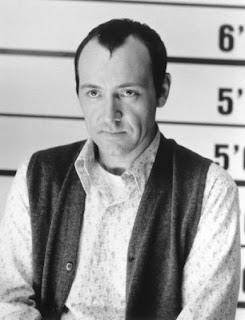
Quite frankly, yes. Throughout the film, key Thriller traits are apparent, and it keeps the audience guessing right until the end. The audience are given occasional clues as to who the 'mythical' crime lord Keyser Soze is, and these only become obvious on the second viewing, once we know the outcome. Key quotes from Verbal Kint, such as "the greatest trick the devil ever pulled was convincing the world he didn't exist" and "like that, he's gone" signify the mystery of the film, and also highlight the character complexity that qualifies the film as a thriller (we later realise he is Keyser Soze). The audience feel sympathy towards Verbal. It appears he has been set up, and 'programmed' by Keaton, who we begin to suspect. Kint is represented as a weak, stupid cripple, who the audience wrongly therefore presume would be unable to mastermind a $1,000,000 heist and deem him incapable of engineering a police line-up. This view is then reinforced when Verbal breaks down in tears in front of Agent Kujon, and admits that Keaton planned everything - there is then even a shot where we see Keaton as Keyser in the harbour. No sooner does the mystery seem a foregone conclusion, Kint leaves the police station and is picked up by Kobayashi; Soze's right hand man. An FBI artist's sketch of 'Keyser Soze', taken from the description by the Hungarian who was pulled out of a drain after the harbour shootout then prints on the police station's fax machine. It is a good likeness to Kint. It then becomes apparent that Verbal Kint is in fact Soze - showing the character complexity and mystery that defines the Thriller genre.
There are many more thriller traits too. Like in most, the film hinges around a crime, and the story needs to be unravelled, keeping the audience guessing. The main character; Verbal Kint, tells the story, as he reports to the detective. The storyline is deliberately misleading: Just as the audience begin to think Keaton is Soze, we realise it is fact Kint; the man we have sympathised with and trusted throughout. Also, when the audience do realise Kint is Soze, we begin to wonder what, if any of the story is actually real - we were made to believe the robbery was a failed heist, for money and cocaine, when in fact it was a very successful assassination - Soze bought and killed the only man who could positively identify him. And did Kint murder his own wife and children, as it is suggested Soze did in the film? The film generally has a very complex structure, and this is highlighted at the end by the double-twist at the end, where all seems to make sense when Keaton is suggested to be Soze... and then we find out it's Kint. The music score also adds to the complexity and 'darkness' of Kint - it gives him an identity, and prepares the audience for action or another twist. Finally, the Low-Key lighting used throughout is also in line with common Thriller traits. It works well with the continuing theme of mystery, and represents how things are 'kept in the dark' until the very ending.
There are many more thriller traits too. Like in most, the film hinges around a crime, and the story needs to be unravelled, keeping the audience guessing. The main character; Verbal Kint, tells the story, as he reports to the detective. The storyline is deliberately misleading: Just as the audience begin to think Keaton is Soze, we realise it is fact Kint; the man we have sympathised with and trusted throughout. Also, when the audience do realise Kint is Soze, we begin to wonder what, if any of the story is actually real - we were made to believe the robbery was a failed heist, for money and cocaine, when in fact it was a very successful assassination - Soze bought and killed the only man who could positively identify him. And did Kint murder his own wife and children, as it is suggested Soze did in the film? The film generally has a very complex structure, and this is highlighted at the end by the double-twist at the end, where all seems to make sense when Keaton is suggested to be Soze... and then we find out it's Kint. The music score also adds to the complexity and 'darkness' of Kint - it gives him an identity, and prepares the audience for action or another twist. Finally, the Low-Key lighting used throughout is also in line with common Thriller traits. It works well with the continuing theme of mystery, and represents how things are 'kept in the dark' until the very ending.
Wednesday, 10 September 2008
Subscribe to:
Comments (Atom)
